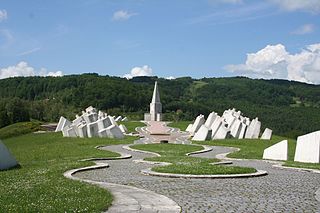 W
WKadinjača is a village, fourteen kilometers from the city of Užice, Serbia, on the route of the highway Užice – Bajina Bašta. It is famous for its memorial of Kadinjača.
 W
WThere were 1,322 individuals who were decorated by the Order of the People's hero of Yugoslavia between 1942 and 1973. Many busts and memorials were built in honor of each People's hero. Each of them usually had a bust in his birthplace or at the place of his death. Most of these monuments are built in figurative style, but some of them were completely abstract, e.g. monument of Ivo Lola Ribar, built at Glamoč field in 1962.
 W
WMemorial Ossuary Cer was built in the village Tekeriš on the mountain Cer. The remains of the killed Serbian soldiers after the Battle of Cer in the First World War were buried there. Memorial ossuary Cer is on the list of Cultural Monuments of Exceptional Importance.
 W
WMonument of Gratitude to France in Belgrade’s Veliki Kalemegdan Park was formally unveiled on 11 November 1930, the 12th anniversary day of the end of the First World War, in the presence of King Alexander and Queen Maria, the royal government, the delegation of the French government, Serbian war veterans, distinguished citizens, associations, schools, and a large crowd of people.
 W
WMonument to the Liberators of Belgrade in Karađorđe's park is an authentic historical place of the camp of the main insurgent army and of the military cemetery of the liberators of Belgrade under Karađorđe in 1806. The monument in the cemetery was erected by Prince Aleksandar Karađorđević in 1848. It is the first monument in Belgrade erected in the honour of a historical event, and at the same time the first public monument.
 W
WMonument to the Soviet War Veterans is a monument located on the Avala mountain near Belgrade, Serbia. It is dedicated to members of the Soviet military delegation who were killed in an airplane crash on the Avala on October 19, 1964. The delegation was flying to Belgrade to attend the celebration of the 20th anniversary of the Liberation of Belgrade on October 20, 1944, since Red Army forces had taken part in the liberation. In the plane crash, Marshal Sergey Semyonovich Biryuzov and general Vladimir Ivanovich Zhdanov were notably killed, among others.
 W
WThe Monument to the Unknown Hero is a World War I memorial located atop Mount Avala, south-east of Belgrade, Serbia, and designed by the sculptor Ivan Meštrović. Memorial was built in 1934-1938 on the place where an unknown Serbian World War I soldier was buried. It is similar to many other tombs of the unknown soldier built by the allies after the war. The Žrnov fortress was previously located on the same place.
 W
WMonument to Vojvoda Vuk is a sculpture in the Park Proleće in Belgrade, Serbia. The sculpture was created by Đorđe Jovanović in 1922 and the monument was erected in 1936. It is dedicated to the most respected figure of the chetnik movement.
 W
WPlava grobnica is an ode written by Serbian poet Milutin Bojić during World War I. It is dedicated to the soldiers that were buried in the sea near Vido island, Greece. In his unforgettable poem, Bojić expressed the tragic fate of Serbia, whose army had passed through Montenegro and Albania to the Greek islands of Corfu and Vido, where over 5,000 Serbian soldiers were buried at sea.
 W
WPobednik is a monument in the Upper Town of the Belgrade Fortress, built to commemorate Serbia's victory over Ottoman and Austro-Hungarian Empire during the Balkan Wars and the First World War. Cast in 1913, erected in 1928, and standing at 14 metres (46 ft) high, it is one of the most famous works of Ivan Meštrović. It is also one of the most visited tourist attractions in Belgrade and the city's most recognizable landmark.